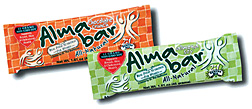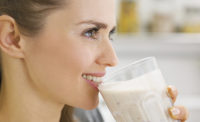
Almond Soy & Tocotrienols
The M.A.F. Group LLC, Boonton, NJ, introduced Chocolate Crunch and Almond Soy health bars under the Alma Bar brand.The bars target women and are formulated with a 2:1 ratio of carbohydrates to protein that is “endorsed by Dr. Phil Maffetone, world-renowned nutrition and human-performance expert” notes the company. “This balanced ratio can be helpful in controlling weight, maintaining energy levels and obtaining optimal brain power.”
The product notes the health benefits of key ingredients as follows.
- Soy protein contains essential amino acids and is a natural source of phytoestrogens which, research shows, improve hormone balance and menopausal symptoms, and help prevent cancer and osteoporosis.
-
Almonds, shown by extensive research to help protect against cardiovascular disease, prevent weight gain and help control blood-sugar problems.
-
Phytosterols support good cholesterol health while carotenoids are powerful antioxidants.
- All four tocotrienols, the complete complex shown in research to support good breast health, balance cholesterol and promote healthy skin.
http://mafgroup.securedata.net— MAF Group's homepage
www.philsbar.com/news/tocotri.htm— MAF Group's website on tocotrienols
*www.tocotrienol.org/sources.htm

Candied Vitamins
Kraft Foods North America's, East Hanover, NJ, Nabisco Fun Fruits brand has introduced Checkers Fruit Snacks.Inside the box, 10 checkerboard pouches contain red strawberry and purple grape-flavored gummi pieces. (Is a Nabisco / Milton Bradley co-branded product next?)
The ingredient statement declares both “ascorbic acid (vitamin C)” and “alpha tocopherol acetate (vitamin E).” The end result is that one pouch of Fun Fruits provides 25% of the Daily Value (DV) of these two nutrients. This is a common formulation for this Nabisco brand. For example, Rugrats Fruit Snacks also contains the vitamin C and E mix.
Vitamin E-fortified confectionery is not exclusive to Kraft, of course. “Vitamin E (as dl-tocopherol acetate) 30IU” graces the label of VitaBall gum balls from Amerifit, Bloomfield, Conn. The product is distributed through health food stores and contains 100% of the DV of 11 vitamins and minerals. The 36 gum balls per package retail for $7.99.

Look at the Back
Bestfoods', Englewood Cliffs, NJ, Hellmann's Light Mayonnaise has been introduced in a new package. What makes the salad dressing intriguing is the dl-alpha-tocopherol acetate (vitamin E) and phytonadione (vitamin K) found on the label, which means the product provides 10% of the DV of vitamin E, and 25% of vitamin K. Although this increased nutrient value is not touted on the front of the package, the label encourages consumers to “See nutrition information for fat content,” which is where the presence of the added nutrients is noted.The Bestfoods' division of Unilever may be on a vitamin E roll. Early last year, it introduced an improved Mazola vegetable oil that “now contains twice the vitamin E of leading vegetable oils.” The addition of d-alpha-tocopherol to the soybean oil means that 30% of vitamin E's DV could be consumed in one serving of 14g, or one tablespoon.
Although these Bestfoods products add tocopherols as vitamin E fortifiers, other oil and salad dressing companies see it as a natural antioxidant in products positioned as healthful. Tocopherol appears on the ingredient statement of the high profile, cholesterol-lowering Benecol salad dressings from McNeil Consumer Products, Fort Washington, Penn. It also serves as an antioxidant preservative in Bernstein's Olive Oil Vinaigrette Dressing from Agrilink Foods, Green Bay, Wisc.
www.bestfoods.com

Meeting Needs
Kellogg USA, Battle Creek, Mich., recently introduced a new package in the U.S. for its whole grain Mueslix. The product is fortified with enough alpha-tocopherol acetate for consumers to obtain 25% of their DV of vitamin E (for a 2,000 calorie diet) from a 2/3-cup serving.
In contrast, Mother's, a brand of Quaker Oats, Chicago, takes the natural route and lists “natural mixed tocopherols (vitamin E)” on the simple, 10-ingredient label of its new Cocoa Bumpers ready-to-eat breakfast cereal. The vitamin is primarily there as a natural antioxidant in that a one-cup serving only provides 2% of the DV for vitamin E.

www.maizoro.com.mx
www.norganic.com
www.sobeys.com

Sidebar: Labeling for E
Generally, vitamin E, an antioxidant, protects both foods and bodies from harmful oxidative reactions. Vitamin E is not just one substance, but is comprised of a family of related compounds. Each of the two basic structures, tocopherol and tocotrienol, are further categorized as alpha, beta, gamma or delta forms.Additionally, alpha-tocopherol, for example, occurs as d- and l- stereoisomers. Only d-alpha-tocopherol is naturally occurring and is more potent in biologic assays when compared to a synthetic alpha-tocopherol mix of d and l isomers.
Recently, the National Academy of Sciences stated in its DRI report that alpha-tocopherol is the primary active form of vitamin E in the body. Based on this, the committee changed the nutritional standard for vitamin E from “alpha-tocopherol equivalents”—which considered activity from the other naturally occurring forms of vitamin E—to “alpha-tocopherol.”
Alpha-tocopherol is consumed in its natural form, largely from oils and nuts, and in its synthetic form, found in vitamins, and other supplements and fortified foods. However, some of these products have begun to tout their natural “d-alpha-tocopherol” ingredient on the label.
It is voluntary as to whether a manufacturer lists vitamin E on its Nutrition Facts panel, unless the product makes a specific claim for vitamin E content. If vitamin E is listed on the Nutrition Facts panel, it is listed as a percentage of the RDI (Reference Daily Intake), which is 30 IU.
The general public is less familiar with tocotrienols, however, interest continues to grow in the health benefits of these compounds. Dietary supplement manufacturers have been the primary marketers of these ingredients, but their use is likely to grow in foods, as well, with companies such as the MAF Group leading the way.
—Claudia D. O'Donnell, Chief Editor
Sidebar: Going Global
Tocopherol is the antioxidant preservative of choice for many food companies around the world. Mintel's Global New Product Database shows that Tipiak, Pont St Martin, France, has rolled out cous cous-based salad mixes in Israel, France, Belgium, Sweden, Finland and South Africa. Key ingredients include items such as mushrooms, roasted garlic, sundried tomatoes, virgin olive oil and Mediterranean herbs. The U.K. version also notes that it “contains a source of fibre and magnesium, and is suitable for vegetarians.” For an antioxidant in such health-oriented products, Tipiak uses “tocopherol rich extract (E306).”
Similarly, Domremy in Japan uses antioxidants vitamin C and tocopherol in chilled desserts, such as the two banana crepes containing fresh cream and whole bananas shown here.
Links
- Sponsored by a supplier, details on tocotrienol
- A retail marketer site on tocotrienol
- FDA release on using tocopherol as a preservative in food
- National Institutes of Health fact sheet on vitamin E
- FDA regulations on vitamin E in Nutrition Facts panel
- Lists health benefits of vitamin E
- Ohio State University fact sheet on vitamin E



